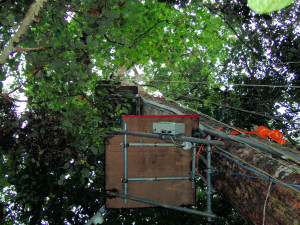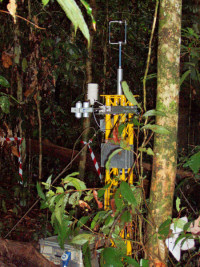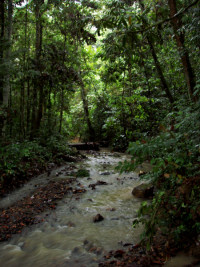ACES Project - Field Measurement Studies
Introduction
Tropical forests are characterised by the greatest BVOC flux of any ecosystem. It is suspected that BVOCs are responsible for a significant fraction of the global aerosol burden and biogenic secondary organic aerosol (BSOA) particles are known to dominate carbonaceous aerosol in remote regions. In addition, since tropical forests have the greatest carbon turnover of all terrestrial ecosystems, it may be expected that a significant amount of involatile carbonaceous material will become available for resuspension as biogenic primary organic aerosol. Many of these biological particles have been found to act as efficient Ice Nuclei and may thus make an important contribution to regulating the hydrological cycle in pristine environments. Yet, the emissions and their role in atmospheric chemistry are largely unknown.
The ACES field measurement programme was designed to develop the objectives of the Oxidant and Particle Photochemical Processes above a South-East Asian Tropical Rain Forest (OP3-Danum-08) project. By integration with OP3-Danum-08, the ACES field measurement programme directly addressed the third main objective of the ACES project "To quantify biogenic volatile organic compound chemistry and aerosol formation in and above vegetation canopies through integrated field studies". Within the OP3 programme, there was an extensive above canopy suite of measurements at the base of, and on, the 100 m GAW tower, located in a very extensive area of tropical forest. ACES enhancement of the OP3-Danum-08 measurementsl fall into three groupings detailed below.
Enhanced characterisation of the organic aerosol components including primary emissions
To supplement OP3 aerosol measurements, and to provide a link between the field campaigns and the chamber studies, University of York used aerosol techniques refined in the chamber experiments to resolve similar small and large molecule composition in ambient organic aerosol. Field aerosol samples were collected using high volume sampling and particle-in-to-liquid sampling, with analysis in the York laboratory.
Since primary aerosol emissions may be very important in controlling the organic aerosol burden and IN potential in remote forested environments, the following measurements were added to the programme at Danum to quantify the importance of biogenic particles:

In-canopy VOC precursor and BOA flux characterisation
Flux measurements carried out as part of OP3 did not include measurements within the canopy. Yet, it has been estimated that typically 10 % of the isoprene emitted from vegetation reacts before it reaches the flux measurement height and this fraction is larger for more reactive compounds such as some monoterpenes and sesquiterpenes, which have mostly reacted by the time they would have left the canopy. Processes in the canopy air space must therefore be probed (and modelled) to develop a more complete understanding of BSOA formation mechanisms. To study canopy processes, ACES made measurements of gas, particle and turbulence properties at multiple heights within and immediately above the canopy. These measurements were based on instruments and inlets mounted on four platforms fixed onto a large emergent tree at heights of 8, 16, 24 and 32m above the ground. Measurements were also made at ground level, and at variable heights in the canopy using a winch driven automatic profile system. The measurements made at the canopy site are sumarised below:

The in-canopy measurements of gases and aerosols provides the constraints for the modelling studies which are also part of the ACES project. In addition, this work establishes the turbulence structure within the canopy so that residence times in the canopy may be estimated. Canopy gradients may be used to derive the vertical distribution of sources and sinks within the canopy and to derive a 'bottom-up' estimate of the canopy emissions for comparison with the above-canopy fluxes. These sources and sinks will include emission/deposition and chemical production/destruction. The results of this work will be linked to the branch level emission measurements to provide a robust dataset with which to constrain the emission model development and to ensure that the laboratory mesocosm studies are representative of the emissions at Danum Valley.
VOC precursor and BOA flux characterisation above an oil palm plantation
This activity addressed the fifth main ACES objective: “To assess the impact of land use changes on aerosol emission/formation and deposition and develop predictive capability”. The OP3 campaigns and the in canopy work described above all take place above class 1 protected primary forest reserve. However, land-use change from primary forest to plantations is a major threat in Southeast Asia. To investigate land-use change impacts, a series of field measurements were taken on oil palm plantations. Previous work has revealed substantial differences in the emissions from rainforest and plantation trees with a 20 fold increase in isoprene flux potential and a 100 fold decrease in monoterpine flux potential above a palm oil plantation as compared to primary rainforest. This part of the project consisted of a measurement campaign above a palm oil plantation between the two OP3 measurement periods and had the following objectives:
These measurements included VOC flux measurements by PTR-MS (isoprene, total monoterpene,
oxygenated VOC), size segregated aerosol number fluxes (0.06 to 1 µm by optical particle counter, UHSAS),
total particle number flux (11 nm – 2 µm) by condensation particle counter (CPC) and speciated aerosol fluxes (nitrate, sulphate, organic marker masses) with a novel eddy-covariance flux system based on the AMS. These measurements were carried out by CEH Edinburgh.
